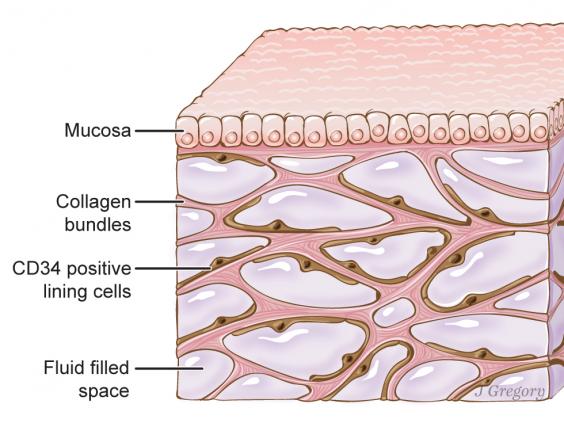"الخلالي" عضو جديد في جسم الإنسان يكتشف مؤخرا
Interstitium
اكتشف فريق من الباحثين الأمريكيين العضو الـ80 من أعضاء الجسم والذي يلقي الضوء على عمل الأعضاء الأخرى والأنسجة وآلية حركة معظم الأمراض.
وأشار الباحثون إلى أن هذا العضو الجديد - يطلق عليه اسم "الخلالي" - هو عبارة عن مساحة مملوءة بالسائل بين الجلد وأعضاء الجسم، بما في ذلك العضلات والدورة الدموية وأن طبقة الأنسجة التي كان يُعتقد أنها غير ملموسة وتوجد تحت سطح الجلد وعلى طول الجهاز الهضمي والرئة والمسالك البولية وحول الأوردة والشرايين وبين العضلات، وهي أجزاء متشابكة ومترابطة مملوءة بسائل يدعمه شبكة البروتينات القوية مثل الكولاجين ومرن مثل النسيج المطاطي.
وقال البروفسور نيل تيز، الباحث المشارك، في هذه الدراسة بمدرسة طب جامعة نيويورك، إنه توصل لاكتشاف هذا العضو بواسطة الاستعانة بالميكروسكوب وأشعة الليزر لمعرفة هذا النسيج المملوء بالسائل، وهذا العضو الجديد يمنع الأنسجة من التمزق، موضحًا أن الخلايا الموجودة في هذا العضو تتغير مع التقدم في السن ما يسبب ظهور أمراض الغشاء الخارجي للأوعية الدموية والالتهابات.
وأشار الباحثون إلى أن هذا العضو الجديد - يطلق عليه اسم "الخلالي" - هو عبارة عن مساحة مملوءة بالسائل بين الجلد وأعضاء الجسم، بما في ذلك العضلات والدورة الدموية وأن طبقة الأنسجة التي كان يُعتقد أنها غير ملموسة وتوجد تحت سطح الجلد وعلى طول الجهاز الهضمي والرئة والمسالك البولية وحول الأوردة والشرايين وبين العضلات، وهي أجزاء متشابكة ومترابطة مملوءة بسائل يدعمه شبكة البروتينات القوية مثل الكولاجين ومرن مثل النسيج المطاطي.
وقال البروفسور نيل تيز، الباحث المشارك، في هذه الدراسة بمدرسة طب جامعة نيويورك، إنه توصل لاكتشاف هذا العضو بواسطة الاستعانة بالميكروسكوب وأشعة الليزر لمعرفة هذا النسيج المملوء بالسائل، وهذا العضو الجديد يمنع الأنسجة من التمزق، موضحًا أن الخلايا الموجودة في هذا العضو تتغير مع التقدم في السن ما يسبب ظهور أمراض الغشاء الخارجي للأوعية الدموية والالتهابات.
Interstitium: New organ discovered in human body after it was previously missed by scientists
Scientists have identified a new human organ hiding in plain sight, in a discovery they hope could help them understand the spread of cancer within the body.
Layers long thought to be dense, connective tissue are actually a series of fluid-filled compartments researchers have termed the “interstitium”.
These compartments are found beneath the skin, as well as lining the gut, lungs, blood vessels and muscles, and join together to form a network supported by a mesh of strong, flexible proteins.
New analysis published in the journal Scientific Reports is the first to identify these spaces collectively as a new organ and try to understand their function.
Remarkably, the interstitium had previously gone unnoticed despite being one of the largest organs in the human body.
The team behind the discovery suggest the compartments may act as “shock absorbers” that protect body tissues from damage.
Mount Sinai Beth Israel Medical Center medics Dr David Carr-Locke and Dr Petros Benias came across the interstitium while investigating a patient’s bile duct, searching for signs of cancer.
They noticed cavities that did not match any previously known human anatomy, and approached New York University pathologist Dr Neil Theise to ask for his expertise.
The researchers realised traditional methods for examining body tissues had missed the interstitium because the “fixing” method for assembling medical microscope slides involves draining away fluid – therefore destroying the organ’s structure.
Instead of their true identity as bodywide, fluid-filled shock absorbers, the squashed cells had been overlooked and considered a simple layer of connective tissue.
Having arrived at this conclusion, the scientists realised this structure was found not only in the bile duct, but surrounding many crucial internal organs.
“This fixation artefact of collapse has made a fluid-filled tissue type throughout the body appear solid in biopsy slides for decades, and our results correct for this to expand the anatomy of most tissues,” said Dr Theise.

